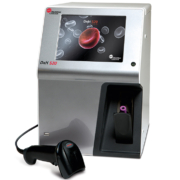5-part differential hematology analyser for small-volume labs
Beckman Coulter Diagnostics has announced achievement of CE Mark of its DxH 520 hematology analyser, designed to help physician office laboratories deliver high-quality results with increased productivity and ease. With as little as two environmentally friendly reagents, the compact 5-part differential system enhances efficiency and resource management through a comprehensive feature set that automates daily tasks. This reduces the amount of time spent on laboratory operations and frees time for patient care. The company used its time-proven flagship DxH 800 hematology solution as the predicate method for the DxH 520 system, establishing a strong correlation throughout the entire DxH line of hematology analysers. This provides a high level of continuity of care for clinical laboratories, regardless of whether they are small- or high-volume facilities. The DxH 520 analyser fills a need for a comprehensive solution that increases productivity while driving down costs for physician office laboratories. It features proprietary dynamic-gating method that improves sample flagging, and reduces slide reviews and technical interpretation, while maintaining effective clinical sensitivity. As an upgrade from a 3-part to a 5-part differential instrument, the DxH 520 analyser gives the clinician more information by which to make decisions when assessing a patient. A robust IT and data-management package helps reduce clerical errors and inefficiencies, and allows for easy retrieval of up to 30,000 patient samples. The system’s small 17 µL aspiration is ideal for puncture samples from infants, geriatric, oncology and critical care patients. Closed tube aspiration capability both simplifies analysis and ensures safety for laboratory technologists by eliminating sample exposure. The easy-to-use interface enables technologists to access any screen in three clicks or less, saving valuable time. The system’s two reagents and on-board cleaner can be replaced in five minutes or less, and its aqueous-based cyanide-, azide- and formaldehyde-free reagents eliminates disposal costs. This is in contrast to competitive systems that use five or more reagents— many of which are primarily composed of organic solvents that require additional costly disposal fees. The analyser’s low-energy requirements – half the power demand of other analysers in its category – further lower operating costs.



